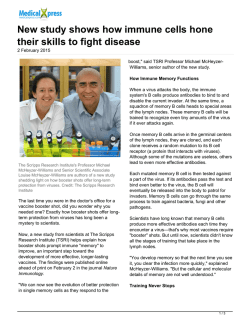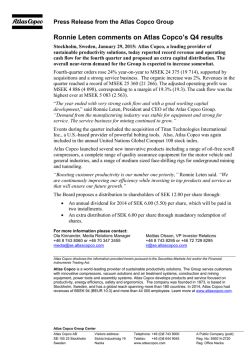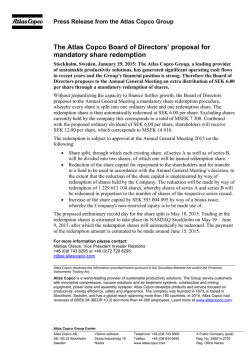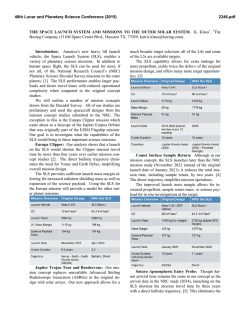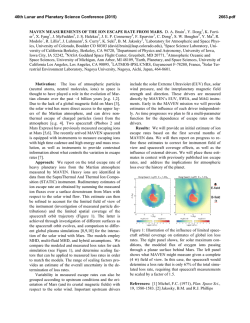
Atlas V MMS Mission Brochure
ATLAS V MMS MISSION A United Launch Alliance (ULA) Atlas V 421 will deliver the MMS constellation to a highly elliptical orbit (HEO). Liftoff will occur from Space Launch Complex 41 at Cape Canaveral Air Force Station, FL. The Magnetoshperic Multiscale mission, or MMS, is a Solar Terrestrial Probes mission consisting of four nearly identical science observatories whose objective is to understand the microphysics of magnetic reconnection. The four MMS spacecraft are designed, built, and operated by Goddard Space Flight Center (GSFC) in Greenbelt, MD. Magnetic reconnection is a universal process that happens when magnetic field lines come together, break apart and then exchange partners, snapping into new positions and releasing a jolt of magnetic energy. This process lies at the heart of giant explosions on the sun, such as solar flares and coronal mass ejections, which can fling radiation and particles across the solar system. Because it’s so difficult to see this process on the sun, and it’s also a difficult process to re-create and study in the lab, researchers plan to take a closer look at magnetic reconnection in space. The four identically instrumented MMS spacecraft will fly in an adjustable pyramid-like tetrahedron formation. By observing magnetic reconnection in nature, MMS provides access to predictive knowledge of a universal process that is the final governor of space weather, affecting modern technological systems such as communications networks, GPS navigation, and electrical power grids. Magnetic reconnection also limits the performance of fusion reactors on Earth. Solving magnetic reconnection has the potential to unlock understanding of a fundamental energy process present throughout the universe that also affects and limits our use of technologies on Earth. Payload Fairing (PLF) The MMS spacecraft is encapsulated in the 4-m (14-ft) diameter Extra Extended Payload Fairing (XEPF). The XEPF is a bisector (two-piece shell) fairing consisting of aluminum skin/stringer construction with vertical split-line longerons. The vehicle’s height with the PLF is approximately 195 ft. Centaur The Centaur second stage is 10 ft in diameter and 41.5 ft in length. Its propellant tanks are constructed of pressure-stabilized, corrosion resistant stainless steel. Centaur is a liquid hydrogen/ liquid oxygen- (cryogenic-) fueled vehicle. It uses a single RL10A engine producing 22,300 lb of thrust. The cryogenic tanks are insulated with a combination of helium-purged insulation blankets, radiation shields, and spray-on foam insulation (SOFI). The Centaur forward adapter (CFA) provides the structural mountings for the fault-tolerant avionics system and the structural and electrical interfaces with the spacecraft. Booster The Atlas V booster is 12.5 ft in diameter and 106.5 ft in length. The booster’s tanks are structurally rigid and constructed of isogrid aluminum barrels, spun-formed aluminum domes, and intertank skirts. Atlas booster propulsion is provided by the RD-180 engine system (a single engine with two thrust chambers). The RD-180 burns RP-1 (Rocket Propellant-1 or highly purified kerosene) and liquid oxygen, and delivers 860,200 lb of thrust at sea level. The Atlas V booster is controlled by the Centaur avionics system, which provides guidance, flight control, and vehicle sequencing functions during the booster and Centaur phases of flight. The MMS mission uses two SRBs which are approximately 61 in. in diameter, 67 ft in length, and constructed of a graphite-epoxy composite. The ULA team is proud to be the launch provider for the Magnetospheric Multiscale (MMS) mission for the National Aeronautics and Space Administration (NASA). MMS will study the microphysics of magnetic reconnection to improve our understanding of this fundamental energy process that limits the performance of fusion reactors on Earth and is the ultimate driver of space weather. The MMS Project Office at NASA’s Goddard Space Flight Center manages the spacecraft and our direct customer for this launch is the NASA Launch Services Program (LSP). The ULA team is focused on attaining Perfect Product Delivery for the MMS mission, which includes a relentless focus on mission success (the perfect product) and also excellence and continuous improvement in meeting all of the needs of our customers (the perfect delivery). We sincerely thank the entire team, which consists of NASA, Southwest Research Institute, ULA, and major suppliers of ULA. Go Atlas, Go Centaur, Go MMS! Jim Sponnick Vice President, Atlas and Delta Programs MISSION OVERVIEW With more than a century of combined heritage, United Launch Alliance is the nation’s most experienced and reliable launch service provider. ULA has successfully delivered more than 90 satellites to orbit that provide critical capabilities for troops in the field, aid meteorologists in tracking severe weather, enable personal device-based GPS navigation and unlock the mysteries of our solar system. Join the conversation: ULALaunch.com Copyright © 2015 United Launch Alliance, LLC. All Rights Reserved. – 4th Atlas V 421 Launch – 12th NASA Atlas V Mission – 53rd Atlas V Launch ATLAS V PRODUCTION AND LAUNCH MISSION PROFILE AND GROUND TRACE 1 Sacramento, CA 6 – Solid Rocket Booster Fabrication at Aerojet Rocketdyne 7 8 9 5 2 Denver, CO – ULA Headquarters & Design Center Engineering 4 3 Harlingen, TX – Payload Fairing, Payload Fairing Adapter, Booste Booster ter Adapter & Centaur Adapter Fabrication 4 Decatur, AL – Booster Fabrication & Final Assembly, Centaur entaur Tank Fabrication & Centaur Final Assembly bly 5 West Palm Beach, FL – RL10A Engine Fabrication at Aerojet Rocketdyne cketdyne 6 Khimki, Russia – RD-180 Engine Fabrication at NPO Energomash 1 3 Interstage Adapter 3 4 5 6 7 8 9 1 Vertical Integration Facility (VIF) (See inset) 2 2 Bridge Crane Hammerhead 3 3 Bridge Crane 4 Launch Vehicle Booster 1 4 -2.7 1.1 5.9 48.9 62.5 138.6 249.7 255.7 265.7 273.7 809.0 4,349.8 4,691.3 5,531.3 5,831.3 6,131.3 6,431.3 -00:00:02.7 00:00:01.1 00:00:05.9 00:00:48.9 00:01:02.5 00:02:18.6 00:04:09.7 00:04:15.7 00:04:25.7 00:04:33.7 00:13:29.0 01:12:29.8 01:18:11.3 01:32:11.3 01:37:11.3 01:42:11.3 01:47:11.3 80 5 7 High Pressure Gas Storage 8 Booster LO2 Storage 60 5 9 Pad Equipment Building (PEB) LION BOSS 40 10 Pad ECS Shelter Spacecraft RD-180 Engine Ignition Liftoff (Thrust to Weight > 1) Begin Pitch/Yaw Maneuver Mach 1 Maximum Dynamic Pressure SRB Jettison Atlas Booster Engine Cutoff (BECO) Atlas Booster/Centaur Separation Centaur Main Engine Start (MES-1) Payload Fairing Jettison Centaur First Main Engine Cutoff (MECO-1) Centaur Second Main Engine Start (MES-2) Centaur Second Main Engine Cutoff (MECO-2) First MMS Separation (MMS-4) Second MMS Separation (MMS-3) Third MMS Separation (MMS-2) Fourth MMS Separation (MMS-1) Longitude (deg) 6 Centaur LO2 Storage Centaur Time (hr:min:sec) Perigee Altitude: 316 nmi | Apogee Altitude: 37,886 nmi | Inclination: 28.77 deg | Flight Azimuth: 99.0 deg 2 5 Mobile Launch Platform (MLP) Time (seconds) COOK ER 4-m Payload Fairing Halves 20 Payload Transporter 0 8 6 HULA 9 TDRS 46 Guam TDRS 171 TDRS 275 TDRS 174 2 1 Solid Rocket Boosters -40 -60 4 3 TDRS 41 -20 1 Telemetry Ground Station Launch Vehicle /Spacecraft Groundtrack TDRS Asset Geostationary Orbital Position -80 6 -135 Mobile Launch Platform 7 Space Launch Complex 41 7 -90 -45 0 45 90 135 8 All Values Approximate Geodetic Latitude (deg) SOC) | Launch 1 Atlas Spaceflight Operations Center (ASOC) Control Center and Mission Director’s Centerr 2 Spacecraft Processing Facility | Spacecraft aft processing, testing and encapsulation 3 Vertical Integration Facility | Launch vehicle Integration and testing, spacecraft mate and integrated operations 2 Event
© Copyright 2026
